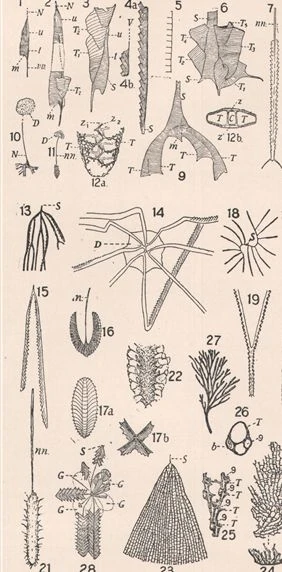
Graptolite morphology illustrated from the Encyclopædia Britannica.
Graptolites (Graptolithinia) were a class in the animal phylum Hemichordata. Graptolites were colonial animals that appeared in Upper Cambrian and disappeared in the Lower Carboniferous (about 510–350 million years ago).
The name graptolite comes from the Greek graptos, meaning "written", and lithos, meaning "rock", as many graptolite fossils resemble hieroglyphs written on the rock. Since the 1970s, as a result of advances in electron microscopy, graptolites have generally been thought to be most closely allied to the amphioxuss, a rare group of modern marine animals belonging to the phylum Hemichordata (hemichordates). Comparisons are drawn with the modern hemichordates Cephalodiscus and Rhabdopleura. Cephalodiscus numbers about 18 species, and was first discovered in 1882.
Each graptolite colony is known as a rhabdosome and has a variable number of branches (called stipes) originating from an initial individual (called a sicula). Each subsequent individual (zooid) is housed within a tubular or cup-like structure (called a theca). In some colonies, there are two sizes of theca, and it has been suggested that this difference is due to sexual dimorphism.[citation needed] The number of branches and the arrangement of the thecae are important features in the identification of graptolite fossils. Their general shape has been compared with that of a hacksaw blade.
Most of the dendritic or many-branched types are classified as dendroid graptolites (order Dendroidea). They appear earlier in the fossil record (in the Cambrian period), and were generally benthic animals (attached to the sea-floor by a root-like base). Graptolites with relatively few branches were derived from the dendroid graptolites at the beginning of the Ordovician period. This latter type (order Graptoloidea) were pelagic, drifting freely on the surface of ancient seas or attached to floating seaweed by means of a slender thread. They were a successful and prolific group, being the most important animal members of the plankton until they died out in the early part of the Devonian period. The dendroid graptolites survived until the Carboniferous period.